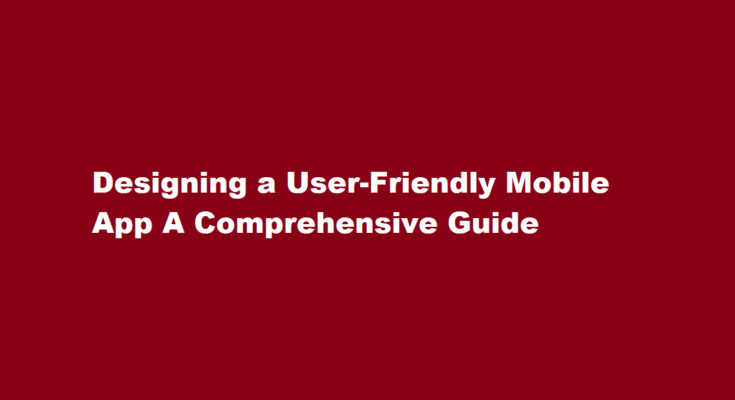Introduction
In today’s digital age, mobile apps have become an indispensable part of our daily lives. However, with the ever-increasing competition in the app market, it is crucial for developers to prioritize user experience to create a successful and user-friendly mobile app. A user-friendly app not only enhances user satisfaction but also leads to higher user retention and increased engagement. In this article, we will delve into the key principles and strategies for designing a unique and informative user-friendly mobile app.
Understand Your Target Audience
The first step in designing a user-friendly mobile app is to thoroughly understand your target audience. Conduct market research and user surveys to identify their needs, preferences, and pain points. Analyze user data from previous apps, if available. This knowledge will guide your design decisions, ensuring that the app resonates with your users.
Simple and Intuitive User Interface
A cluttered and complicated user interface can be a significant deterrent for users. Aim for simplicity and intuitiveness in your app’s design. Use familiar icons and gestures to minimize the learning curve for users. Employ a consistent and logical navigation flow to enable users to accomplish their tasks efficiently.
Optimize App Speed and Performance
Nothing frustrates users more than a sluggish app. Optimize your app’s speed and performance to ensure seamless user experiences. Minimize loading times, compress images, and cache data intelligently. Regularly test the app on various devices and platforms to maintain high performance levels.
Prioritize Visual Hierarchy
A well-structured visual hierarchy helps users understand the app’s content and interactions. Use appropriate font sizes, colors, and contrast to highlight important elements. Group related information together and create clear call-to-action buttons for ease of use.
Implement Responsive Design
With the vast array of mobile devices available, it is crucial to create a responsive design that adapts to different screen sizes and orientations. This approach guarantees a consistent user experience across various devices, enhancing usability and satisfaction.
Seamless Onboarding Process
The onboarding process is the user’s first interaction with your app. Make it seamless and engaging to capture their interest from the start. Limit the number of steps required for registration and offer the option to log in through social media accounts. Provide a brief tutorial or guide to showcase your app’s core features.
Prioritize Accessibility
Designing an inclusive app is essential for catering to all users, including those with disabilities. Adhere to accessibility guidelines to ensure that your app can be used by everyone. Offer options for adjusting text size, providing alt text for images, and supporting screen readers.
Error Handling and Feedback
Errors are inevitable in any app. When they occur, provide clear and concise error messages that guide users on how to rectify the issue. Additionally, offer feedback for successful actions to reassure users that their interactions are effective.
Testing and User Feedback
Extensive testing is crucial in identifying and resolving potential usability issues. Conduct usability testing with real users to gather feedback and insights on the app’s usability and design. Iterate and refine the app based on this feedback to enhance the user experience continuously.
Personalization and Customization
Personalization creates a sense of ownership and improves user engagement. Offer customization options that allow users to tailor the app to their preferences. This may include themes, language settings, or content preferences.
Limit Permissions and Notifications
Respect user privacy by requesting only essential permissions and explaining why they are necessary. Minimize push notifications to prevent overwhelming users and ensure that they find value in the notifications they receive.
FREQUENTLY ASKED QUESTIONS
What are 4 design areas to build a successful mobile app?
This article’s focus is to outline 15 success drivers common across all mobile apps in four areas of mobile app development: product strategy, mobile app architecture, user experience design, and mobile app marketing.
What is highly user-friendly?
User-friendly is a term we use to describe anything that is easy to learn how to use. It is also easy to use. In other words, even if it is sophisticated, using it is simple and straightforward. We use the term for computer interfaces, devices, equipment, facilities, and systems.
Conclusion
Designing a user-friendly mobile app is a multifaceted endeavor that requires careful consideration of user needs, preferences, and expectations. By prioritizing simplicity, responsiveness, and accessibility, you can create a unique and informative app that delights users and keeps them coming back. Regularly update and improve your app based on user feedback to maintain its relevance and user-friendliness. Remember, a well-designed app not only garners positive reviews but also cultivates a loyal user base, ensuring the success of your app in the competitive mobile market.
Read Also : Designing a Custom Workout Routine to Achieve Your Fitness Goals



